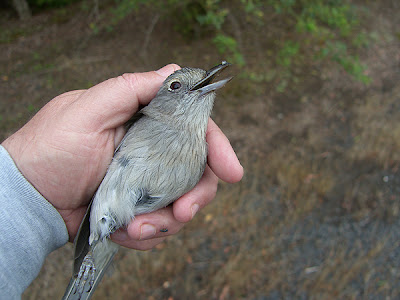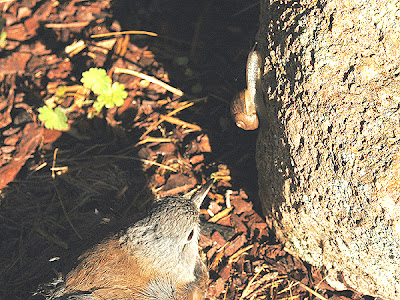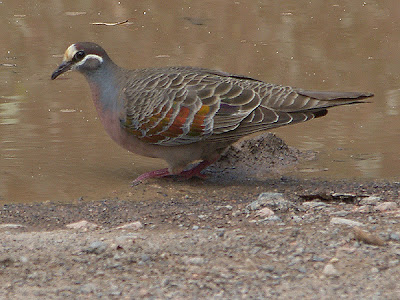 Here below is a panoramic view of from the Red Door Gazebo. It truly is an awesome location. Click on the image to enlarge it.
Here below is a panoramic view of from the Red Door Gazebo. It truly is an awesome location. Click on the image to enlarge it.The river flows from left to right. It loops around a small ridge, in the centre of the gorge directly in front of the viewer. On the far right of the enlarged image, you will be able to discern a cultivated river flat, which is where a tributary creek flows down to join the Wollondilly River. The huge efforts which early settlers went to in order to access arable land amazes me. Even today this land is difficult to access. Imagine doing that work with bullock teams. And that land has to be accessed from the far side of the river, some 20 minutes drive away (on "modern roads" - well sort-of), even though it is "just down the hill".
 And here is a contrast of scale - from the macro views of the gorge, to a hand-held Grey Shrike-thrush (Colluricincla harmonica). I found this bird on the drive out to Bullio. It had been hit by a car just moments before I arrived, as there were feathers still floating in the air when I saw the bird on the road, and stopped to rescue it. It had to be moved off the road, if it was to have any chance.
And here is a contrast of scale - from the macro views of the gorge, to a hand-held Grey Shrike-thrush (Colluricincla harmonica). I found this bird on the drive out to Bullio. It had been hit by a car just moments before I arrived, as there were feathers still floating in the air when I saw the bird on the road, and stopped to rescue it. It had to be moved off the road, if it was to have any chance. In keeping with standard "wildlife rescue" techniques, I kept the bird quiet, in a dark position for a while. It did not have a broken wing (or other obvious structural damage), so it was most likely suffering from shock only. After about 45 minutes, it had recovered greatly from when I first rescued it, so I decided to liberate it. It was not able to fly (yet) but I decided to let it take its chances, seeing as it was actively contemplating this snail.
In keeping with standard "wildlife rescue" techniques, I kept the bird quiet, in a dark position for a while. It did not have a broken wing (or other obvious structural damage), so it was most likely suffering from shock only. After about 45 minutes, it had recovered greatly from when I first rescued it, so I decided to liberate it. It was not able to fly (yet) but I decided to let it take its chances, seeing as it was actively contemplating this snail. DJW Note: 12/12/07. I sought advice from the Canberra Ornithologist Group (COG) discussion group on sexual dimorphism in Grey Shrike-thrushes. The answer came back from immediately. Female, probably 2 year old. Immature birds have brown markings on their heads, and heavily striated chests. The striations gradually reduce, until 3 years of age, at which point, males have developed a fully white face. Males have a fully black beak, whereas females have a grey lower mandible (as does this bird). QED. Thanks to the COG discussion group people.
DJW Note: 12/12/07. I sought advice from the Canberra Ornithologist Group (COG) discussion group on sexual dimorphism in Grey Shrike-thrushes. The answer came back from immediately. Female, probably 2 year old. Immature birds have brown markings on their heads, and heavily striated chests. The striations gradually reduce, until 3 years of age, at which point, males have developed a fully white face. Males have a fully black beak, whereas females have a grey lower mandible (as does this bird). QED. Thanks to the COG discussion group people.On the way back home, I spotted this lovely Common Bronzewing (Phaps calcoptera) - a Pigeon - beside a shallow pool in a parking area. The colour patches from which this bird takes its name are derived from an iridescent sheen on the wing feathers, which reflect light in tones ranging from green, to reddish-bronze. The colour patches on the wings appear to change, because it is a reflected light effect, rather than a "solid colour" based upon pigment (unlike the other colours on the head and breast - which are constant).
 Pigeons are quite thirsty birds, it seems. I have noticed before that Pigeons and parrots (both seed eaters) are often to be seen beside waterholes, and this bird is quite typical in that regard. The COG bird images gallery has fourteen images of this species, and four show them drinking from shallow pools, just like this bird.
Pigeons are quite thirsty birds, it seems. I have noticed before that Pigeons and parrots (both seed eaters) are often to be seen beside waterholes, and this bird is quite typical in that regard. The COG bird images gallery has fourteen images of this species, and four show them drinking from shallow pools, just like this bird. I was slightly unsure if this was a Common or Brush Bronzewing. But the COG photo gallery make it clear that it is the "Common Bronzewing". The white eye line is distinctive. By contrast, the Brush Bronzewing has a prominent dark line through the eye. This bird was very placid, and allowed me to take many images before it departed, after it had had its drink.
I was slightly unsure if this was a Common or Brush Bronzewing. But the COG photo gallery make it clear that it is the "Common Bronzewing". The white eye line is distinctive. By contrast, the Brush Bronzewing has a prominent dark line through the eye. This bird was very placid, and allowed me to take many images before it departed, after it had had its drink.

2 comments:
I love the bronzewing. So beautiful! Such colours!
And I love the Red Door Gazebo.
Blessings and bliss
Thanks, Miss Eagle
I love it too. Subtle "bush" colours (perfect camouflage - except when standing out in the open to drink form a roadside puddle), yet unimaginable beauty.
Glad you liked it.
Denis
Post a Comment